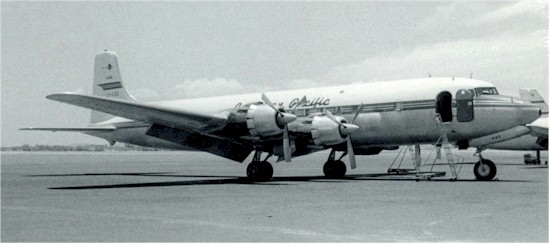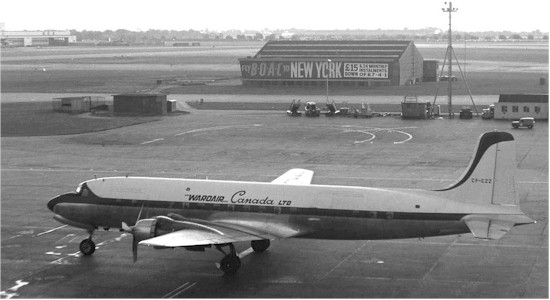|
Continuation of the DC-6 story started in NetLetter #1531 -
Canadian Pacific Air Lines (CPAL) was one of the most important airlines of Canada at the time, with an extensive network of domestic and international scheduled routes. By July 1958 the airline already had a large fleet of Douglas DC-6B's with which, among many other achievements, it had pioneered an 'over the top' trans-Arctic route linking Vancouver with Amsterdam, which included a fuel stop at Sondrestrom Air Base in Greenland. It also flew to the Orient across the Pacific Ocean, with services to Tokyo and Hong Kong and to destinations in the Pacific and South America. London was reserved by the Canadian Government for Trans-Canada Air Lines, but CPA served a number of other European cities, including Lisbon, Madrid and Rome.
During 1958 CPA took delivery of six Bristol Britannia 314's intended to replace the DC-6B's on the international routes, but that year they also acquired an additional DC-6B, two DC-6A's and one convertible DC-6A/B, the subject of this article. Two more Britannias were delivered in 1959. A report in "Flight" magazine March 7, 1958 noted, "Four DC-6A's are soon to be delivered to permit CPA to bend more of their energies to scheduled and charter air-freighting as passenger aeroplanes, to which they are of course quickly convertible, the DC-6A's will be marketed to the public as DC-6B's. With six Britannias doing the international network of ten DC-6B's, and with five other DC-6B type aircraft available, it looks as though CPA may have some surplus capacity on hand.
A CPA engineer's reaction was simply the DC-6B is the most adaptable transport yet built. We can put it on any route you like and make money. "We'll find a use for it."
Our subject aircraft was ordered in May 1958 as a DC-6A pure cargo aircraft. By bill of sale dated July 11, 1958, Douglas Aircraft Company sold msn 45498 to Canadian Pacific Airlines for $1,238,580, and the aircraft was delivered from the factory at Santa Monica, California to Vancouver, British Columbia. Receiving its Canadian Certificate of Airworthiness (C of A) on July 8, 1958 and formally registered to CPAL as CF-CZZ on July 23, 1958.
It was painted in full CPAL colour scheme and assigned the fleet number 446. It was then back to California, to AiResearch Aviation Services Company at Los Angeles International Airport, where it was modified to a convertible passenger/cargo DC-6A/B. and on February 1, 1959 it was delivered back to Vancouver and entered regular airline service with CPAL.
|
 |
|
CF-CZZ at Honolulu International July 1959
Photo courtesy of George Trussell
|
|
At the time of its introduction into Canadian Pacific service, the DC-6B fleet was responsible for three departures weekly from Vancouver to Amsterdam via Edmonton and Sondrestrom, together with twice weekly services from Vancouver to Honolulu. Another once weekly service was flown from Vancouver, via Honolulu to Nandi (Fiji), Auckland and Sydney via a refuelling stop at Canton Island.
Twice weekly flights were also made over the route Vancouver-Mexico City-Lima-Santiago-Buenos Aires: a once weekly flight routed Montreal-Santa Maria-Lisbon; and there was a twice weekly service from Mexico City to Toronto and Montreal, which then tracked eastbound across the Atlantic via Santa Maria to Lisbon and Madrid. DC-6's also saw limited deployment on the domestic routes, with the type flying a five times weekly service from Vancouver to Terrace via Sandspit, and a twice weekly Vancouver-Prince George-Fort St John-Whitehorse schedule.
In later years, the DC-6B fleet became the primary aircraft type serving CPA's routes within British Columbia, Alberta and Yukon, until replacement by the Boeing 737-200 on those routes during late 1968 and early 1969, in conjunction with introduction of the new CP Air branding and orange and red livery.
The last DC-6B's were retired from service in April 1969 when CP Air became an all-jet airline except for a single DC-3 retained for some time for pilot training purposes.
|
|
Douglas DC-6A/B CF-CZZ only served with Canadian Pacific Air Lines for three trouble-free years, carrying passengers and cargo on scheduled and charter flights, before being leased to Wardair.
By 1962, when the Douglas DC-8-43 had joined the fleet, it was time for CF-CZZ to move on. On March 14, 1962 it was leased to Wardair Canada Ltd., registered to that company and painted into its most attractive red and white colour scheme.
To be continued in NetLetter #1533.
|
 |
|
CF-CZZ London-Heathrow circa 1963
Photo courtesy of Dave Welch
|
